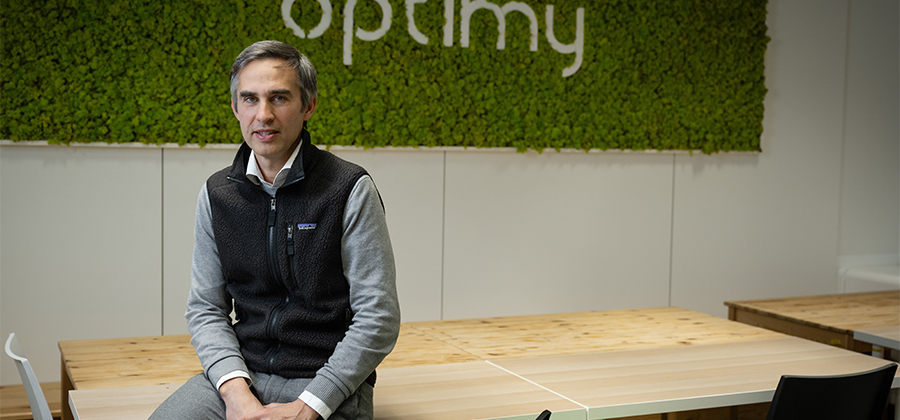Would you like to know what people will want next? If so, all you have to do is look at successful innovations and the expectations they generate, according to David Mattin, trendwatcher at www.trendwatching.com and co-author of the book Trend-Driven Innovation.

Any professional is long accustomed to the hyper-accelerated pace of innovation that sees new products and services arrive and disappear at light speed. With that comes the sense that consumer behaviours and mindsets change faster, more unpredictably — chaotically, even — than ever. Put together, it's an avalanche that can feel overwhelming.. That is, in summary, what David Mattin writes in his article How to spot a trend at www.trendwatching.com.
Still, being on board wih the latest trends or even anticipating them doesn't have to be the preserve of a chosen few with seemingly magical intuition, Mattin says. According to him, trendspotting can be a simple, replicable process that anyone can do. His article provides a model that answers the question that any start-up, CEO, marketing director or product developer struggles with: what will my customers want next?
Human needs
There are various methods to determine what customers want. Traditional market research is the most well-known method. Yet Mattin believes this method is inadequate to spot future trends in an environment of rapid change.
”After all, our job is to figure out what people will want before they want it. People often don't know what they want until you show it to them."
Observing potential customers with ethnographic fieldwork is another research method. This can yield deep insights, but it is hard, slow and expensive. Big Data can provide useful customer information, but it usually only allows you to optimise what you’re already doing. Big data rarely generates the radical insights that can underpin something truly new, Matting claims.
So what’s the answer? The key to actionable foresight lies in looking at the overwhelming onslaught of innovation — new brands, products, services, campaigns, experiences and more — that now parade before our eyes and across our screens every day.
Mattin: "The ultimate answer lies in the customer expectations those innovations are creating. In order to be successful, businesses must meet those expectations at the right time.”
In order to spot consumer trends, it is essential to define what a trend is exactly. According to the trendwatcher a trend is a new manifestation - in behaviour, attitude or expectation - of a fundamental human need or want, usually via a new technology or an economic or social change. In other words:, when an age-old human need: for connection, security value, excitement… is served by a new technology, this will most likely introduce a new trend. A good example of this is Napster, the well-known illegal music streaming platform from 1999 This innovation served the basic needs ‘novelty’ (more music) and 'convenience' (instant access). It was this innovation that has led to iTunes, Netflix and Spotify, all of which satisfy those needs and are extremely successful.
Learning from Uber
But there's still a piece of the puzzle missing. How does a cluster of innovations that serve a basic need in a new way become a worldwide trend? The answer lies in two words: expectation transfer.
David Mattin: “When an innovation serves a basic human need in a new way, it sets new customer expectations: it primes consumers to expect something new. Once created, new expectations spread across markets, industries, product and service categories.”
He refers to Uber as an example, with which the basic human needs of 'convenience' and 'low-cost transport' are served. The iconic innovation of Uber raised consumer expectations of one-touch smartphone fuelled services, and these expectations were served by others, such as Handy, an American on-demand home services start-up that earned 50 million dollars in just one month.
Mattin claims it is crucial to watch as many innovations as possible, as this allows you to tap the collective intelligence of the business crowd around the question: what will customers want next? When you spot a cluster of similar innovations, you'll know that you could be on to an interesting new signal of where customers are heading. The trendwatcher also emphasises to not dismiss innovations that seem niche or even ridiculous — they can often be weak signals of powerful new emerging expectations.
“Remember when couch-surfing was just for students and broke travellers? Now, Airbnb will let you rent the Villa Machiavelli in Tuscany for 5,164 pounds per night”, Mattin argues.
Goldmine of opportunities
The trendwatcher concludes that in order to spot trends, you should start interrogating every innovation you see for the new customer expectations it creates, and pretty soon it will become a habit.
“That habit becomes something more: a new way of seeing the world that turns the overwhelming flood of innovations into a goldmine of opportunity. Of course, you'll need to apply the trends you spot. That means turning them into winning new innovation ideas, and then executing.”
(Source: www.trendwachting.com)
16.12.2024
The digital divide persists
“It's not just the elderly who lack digital skills, young people and workers are also affected,” says Linde Verheyden, Director Public Affairs at BNP Paribas Fortis and Chair of DigitAll.
Despite the acceleration in digitalisation, many people are being left behind. In Belgium, 40% of the population between the ages of 16 and 74 are at risk of digital exclusion. Although older people are often seen as the most vulnerable group, younger people are also struggling in the digital age. Among young people aged between 16 and 24, almost a third lack basic digital skills, with a peak of 52% among those with a low educational attainment.
Figures that are surprising to say the least, considering young people grow up surrounded by digital tools.
"People often assume that young people are digital natives because they are adept at using social media. But making a TikTok video or scrolling through your Instagram feed doesn't necessarily mean you know how to carry out online banking transactions or complete an application form.
Does poverty play a significant role in the digital divide?
"Absolutely. For 25% of people living in poverty, a smartphone is their only digital device. Although they provide a basic form of access, smartphones are often inadequate for important tasks such as preparing a CV or filing a tax return. Without a computer or a stable internet connection, many digital opportunities remain out of reach for those who don't have access to these tools.
What are the other reasons for this digital divide?
"People often lack the necessary basic digital skills because they never learned them. They may not know how to use a search engine, attach a file to an e-mail, or download an app. Without this knowledge, the digital world becomes inaccessible. Furthermore, there is also the issue of digital stress. Many people worry about making mistakes, being hacked, or their privacy. Some people deliberately choose not to use digital services even though they have the skills. Technology instils a sense of distrust and unrest in them, creating a significant barrier.”
How can companies help close this gap?
"Companies can play a key role on several levels. In addition to being a social problem, digital exclusion is also an economic challenge. Today, less digitally adept individuals are both customers and potential employees. Being aware of this as a company is the most important first step. But it’s also essential to provide support to your staff. For example, employees at the municipal parks and greenery service in Ghent received training on how to file their tax returns online. These kinds of initiatives give people practical skills and confidence. In addition, companies need to do a digital check. To measure is to know. Just because someone uses a laptop daily, it doesn’t mean they have digital skills."
What does BNP Paribas Fortis do specifically to promote digital inclusion?
"We have launched several initiatives. In 2020, we established DigitAll, a platform for sharing knowledge and best practices around digital inclusion. Today, we bring together more than 130 organisations. DigitAll has developed a range of tools, including a checklist that companies can use to test how accessible their apps and websites are. A simple interface can make the difference between joining or dropping out for people who are less digitally adept. Since 2021, the bank has also supported a chair at the VUB that investigates the link between digital inclusion and human rights."
How important are tools in bridging the digital divide?
"User-friendly tools are a must. We have partnered with Emporia, a manufacturer of user-friendly smartphones for the less digitally adept. We pre-install our app for customers who buy one of their smartphones."
We mentioned digital stress earlier. How can you mitigate this?
"With awareness campaigns. We want our customers to use our tools with confidence. The bank also takes its less digitally adept customers into account. Thanks to our partnership with bpost, all our customers can go to their local post office for all basic banking transactions."
Do companies stand to benefit from promoting digital inclusion?
"They do. Digital inclusion requires a sustained effort from all stakeholders, including governments and educational institutions. No one should be left behind. Companies that act now can contribute to a more inclusive society while also securing their own future in an increasingly digital world.”
“Without key digital skills, many digital opportunities remain out of reach.”
“A simple interface can make the difference between joining or dropping out for people who are less digitally adept.”
“Limited digital skills remain an obstacle to closing the digital divide.”
Linde Verheyden, Director Public Affairs at BNP Paribas Fortis and Chairman of DigitAll
09.12.2024
Managing business uncertainty with BNP Paribas Fortis
Every entrepreneur will tell you that financial markets are unpredictable, entailing inherent risks. We provide tailored solutions to protect your business as you navigate these volatile markets.

Whether you’re a small or large business, operating domestically or internationally, one thing is certain: if you enter a market and do your utmost to grow your business, sooner or later there inevitably will come a time when you expose yourself to risks. Frédéric Raxhon, Head of FI Midcap Sales, BNP Paribas Fortis Transaction Banking, is our go-to expert. Here, he explains how BNP Paribas Fortis helps customers manage this uncertainty.
Raxhon knows how market volatility can impact the daily operations of small, medium and large enterprises. Thanks to his experience of working as a banker in corporate finance, shares and derivatives, and advising holding and listed companies, he understands how the market works like no other.
Raxhon: "We are keenly aware that price uncertainty, in the form of volatility on the financial markets, can have a serious impact on the operations and profitability of businesses. That’s why we constantly monitor the markets and their volatility: if prices fluctuate sharply, our customers run the risk of buying high and selling low. The past few years are a good example of what can happen, with a sudden rise in interest rates, an energy crisis with very volatile prices, and a sharp rise in inflation. We will continue to see volatility in these markets, due to geopolitical tensions and ongoing wars. However, elections can also cause volatility, as they often cause a change in economic policy. President-elect Donald Trump has already said that he will hike tariffs on goods coming from outside the U.S., which will have an impact on global growth and inflation. The transition to a more sustainable society because of the energy transition, however positive this may be, is also a source of uncertainty. Companies will be required to make significant investments, and it is not yet clear which technologies will prevail.
All of these factors show that companies need guidance in the form of a tailor-made solution to ensure that volatile markets minimise the impact on their operations so that they can focus on their core business."
Solution-oriented
The solution to this volatility comes from a partner who is a market leader when it comes to safeguarding national and international business.
Raxhon: "At BNP Paribas Fortis, this often means managing the risks of companies that have a number of straightforward wishes: they want to conduct business on a daily basis without unnecessary complications; buy at a stable price where possible; pay wages in a stable environment; sell to customers with a profitable, stable margin, and so on. If they experience market uncertainty in their business operations, we are there to advise them and suggest solutions in different scenarios. This can range from companies that want stability when buying or selling goods in another currency, to controlling fluctuating interest rates on current or future loans, or even creating a stable financial environment in which they can steadily pay their wages. We also hedge raw materials: companies that require large quantities of energy, metal, or wheat, for example – just a few of the commodities that are subject to price fluctuations – can rely on our expertise to turn their uncertainty into certainty. When companies are calculating their budgets for the coming years at the end of the year, assumptions about budgets and costs are a factor that future markets do not take into account. This, in turn, could lead to inconsistencies in business operations during the next financial year. We regularly suggest solutions for this, which inject trust into the entire process. We help entrepreneurs make their business more resilient to market fluctuations. Because at BNP Paribas Fortis, we are always focused on finding solutions, in any given scenario."
International intelligence
Belgian companies are increasingly expanding their horizons, which is why an international perspective is so crucial.
Raxhon: "Everything is intricately connected in the economic space. The energy crisis, for example, was not a national crisis. In Belgium, electricity prices were directly impacted by the drop in nuclear power production in France in 2022. The American elections have a direct impact on international business, with anxiety gripping investors and the markets. And I can give you many more examples.
Moreover, we expect this interdependence and volatility to continue for quite some time: there are a large number of economic and global trends that are feeding this uncertainty. And that is why it is so important that we keep up with developments in this uncertain global environment. At BNP Paribas Fortis, we rely on a global network of experts who are always on the lookout for the latest updates. Whatever happens and wherever it happens, there are always people from our bank on the ground who monitor the situation and provide us with real-time advice on how best to inform our customers. This network has proven its worth time and again, both for us and our customers."
02.05.2024
“Our focus is on people and trust”
Can a fashion company be successful even if it forgoes the excesses of fast fashion? Definitely, as Jean Chabert proves with Stanley/Stella, which produces custom-made clothes from organic cotton.
“We want to be a game changer,” says Jean Chabert, CEO of Stanley/Stella. "When I was born 62 years ago, 2 billion people were living on our planet. Today there are 8 billion. That’s the reality, so we need to stop depleting resources. Human activities always have consequences, but we must constantly strive to improve. That’s our commitment, and we enshrined it in a charter in 2022. We monitor our entire ecosystem and focus on people and trust."
Clothing as a means of communication
The B2B company from Brussels sells clothing that serves as a means of communication. Stanley/Stella customers have T-shirts, sweatshirts and hoodies printed or embroidered and they offer these personalised items to their own customers. "We're in a giveaway industry, and our prices are at least 50 per cent above the average. But we offer superior quality and respect for people," says Chabert.
Organic cotton: half the water
15 of the 220 Stanley/Stella employees are directly or indirectly involved in Environmental, Social, Governance (ESG) activities. For example, they check that agreements on working conditions and safety at the production sites are respected. The company buys its organic cotton, produced without Genetically Modified Organisms (GMOs) or pesticides from India, Tanzania and Turkey - it uses 70 per cent less water than conventional cotton. Stanley/Stella has also made long-term commitments throughout the production chain to minimise any negative impacts on people and the environment. For example, 90 per cent of containers arrive at the warehouse in Germany by inland waterway, the least polluting form of transport.
Considering all the impacts
“Of course, we have to remain realistic,” Chabert adds. "Companies that want to be viable must also remain profitable. By definition, we use resources to make textiles. So, we consider all the impacts. For example, we continue to operate our textile decoration business in Europe, even if it's more expensive. Wastewater containing inks and dyes is treated and reused. At the moment, we can't avoid electricity being generated by gas in Bangladesh. We check how willing a country is to make progress in this area. And in the meantime, we offset what we can't avoid."
Trust and humanity
“Trust is at the heart of any good relationship,” says Chabert. "I used to have a cash flow problem. I relied on my own equity and for years, had no loans. I was the only shareholder for a long time. Eventually, I opened my capital to 40 per cent and applied for loans from BNP Paribas Fortis. Today, we know each other well, and I don't have to explain my company's limitations; they know the industry. They co-finance the stock, offer an invoicing solution, support our development in the United States thanks to their international network, and much more."
Today, it’s full steam ahead for Stanley/Stella. In 2023, turnover more than doubled to EUR 170 million. The company also hopes to enter Japan and South Korea soon. For Chabert, one thing is clear: "Our most important wealth is not on the balance sheet. It’s our people."
Stanley/Stella is ready to change the world. Discover more entrepreneurial stories.
We monitor our entire ecosystem, focusing on people and trust.
Our prices are at least 50 per cent higher than the average. But we offer superior quality and respect for people.
30.04.2024
Measurable corporate social responsibility
The Brussels-based scale-up Optimy brings together corporate volunteering, donations, patronage and sponsorship activities all on one platform. On it, their impact on society is concretely measurable.

"Originally, I didn't think of myself as a social entrepreneur, even though I was involved in sponsorship. At the request of our customers, my partners and I have developed an entire provision of services that has become the most comprehensive platform on the market," says Kenneth Bérard, CEO of Optimy.
One of these customers was the BNP Paribas Fortis Foundation, which wanted to make a greater social difference and also give these actions more visibility. "It's a must for companies to contribute to society. This generates added value for the company and fuels a positive spiral. But that social impact has to be measurable. How many children have been helped? How many trees have been planted? What effect does this have on employee satisfaction, image and turnover? Our model offers all of this. This means that companies don't have to purchase new modules every time they want to add additional activities. I think that’s our great success factor. We are the market leader in Europe in our sector and the only company operating in both Europe and North America."
Personal support
"Many companies are full of good intentions. They want to have a positive impact on society, but they often lack a good method to do this efficiently," the entrepreneur notes. "They tend to see all their efforts in isolation. The Optimy platform offers a solution for this. It's easy to put together and it's service-oriented. We adapt to the processes of each business unit and company. It doesn't work the other way around," assures Bérard. "Our customers are not looking for technology; they're looking for guidance. We invest in personalisation, and it's paying off, as a customer satisfaction survey shows."
Structuring actions
The first piece of advice that Optimy always gives companies is: don't shred your efforts, they should form a whole. "We recommend that companies structure their actions using our tool. The corporate social responsibility policy must be in line with the company’s values, DNA and broader strategy. And of course, the actions must be transparent and well executed."
The right partner
From the beginning, the connection Optimy had with BNP Paribas Fortis was decisive for the company’s growth. "The fact that the bank follows us has increased our credibility with our partners, investors, customers and also internally. Now it's setting up a factoring service for us to further support our growth."
Optimy's growth was initially supported by cash flow, which is unusual for a technology company. Financing came into play beginning in 2019. That's when a Canadian fund specialising in software as a service (SaaS) companies and affiliated with the prestigious Massachusetts Institute of Technology (MIT) became a shareholder.
Multicultural enrichment
As with increasingly more companies, one of Optimy’s biggest challenges is recruiting new talent. “We've been able to convert that challenge into an asset,” concludes Bérard. "We attract talent from abroad. Sixty people from twenty nationalities work in our Brussels branch. This multiculturalism is a huge enrichment and has helped us break through internationally."
“The corporate social responsibility policy must be in line with your company’s values, DNA and broader strategy”.
